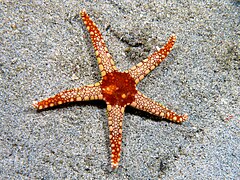
Starfish or sea stars are star-shaped echinoderms belonging to the class Asteroidea. Common usage frequently finds these names being also applied to ophiuroids, which are correctly referred to as brittle stars or basket stars. Starfish are also known as asteroids due to being in the class Asteroidea. About 1,900 species of starfish live on the seabed in all the world's oceans, from warm, tropical zones to frigid, polar regions. They are found from the intertidal zone down to abyssal depths, at 6,000 m (20,000 ft) below the surface.

The Asterinidae are a large family of sea stars in the order Valvatida.
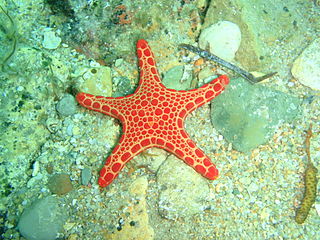
Goniasteridae constitute the largest family of sea stars, included in the order Valvatida. They are mostly deep-dwelling species, but the family also include several colorful shallow tropical species.

Culcita novaeguineae is a species of starfish. It has short arms and an inflated appearance and resembles a pentagonal pincushion. It is variable in colour and can be found in tropical warm waters in the Indo-Pacific.

Culcita is a genus of sea stars. They are found in tropical waters. Some are kept in home aquariums.

Solaster dawsoni, the morning sun star, is a species of starfish in the family Solasteridae. It is found on either side of the northern Pacific Ocean. It has two subspecies:
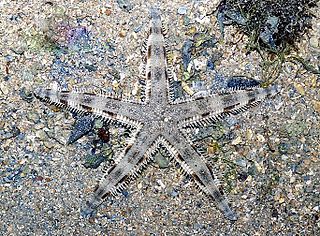
Archaster typicus is a species of starfish in the family Archasteridae. It is commonly known as the sand star or the sand sifting star but these names are also applied to starfish in the genus Astropecten. It is found in shallow waters in the Indo-Pacific region.

Hippasteria is one of 70 genera of sea stars in the diverse family Goniasteridae.

Fromia is a genus of starfish belonging to the family Goniasteridae.
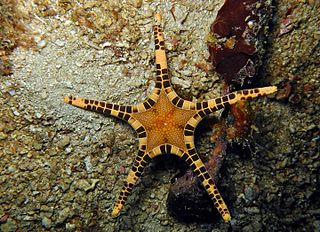
Iconaster longimanus, the icon star or double star, is a species of starfish in the family Goniasteridae. It is found in the west and central Indo-Pacific Ocean. The genus name comes from the Greek eikon, meaning portrait or image and possibly referring to the way the marginal plates frame the disc, and aster, meaning star. The specific name comes from the Latin longus manus and refers to the long, slender arms.

Fromia milleporella, common name red starfish or black spotted starfish, is a species of starfish belonging to the family Goniasteridae.
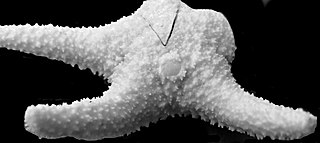
Bathyporania ascendens is a species of starfish in the family Poraniidae, and the only species of the genus Bathyporania. It is native to the Pacific Ocean and is found in deep water off the coast of North America.

Fromia indica, commonly called Indian sea star or red starfish, is a species of marine starfish belonging to the family Goniasteridae.

Fromia elegans, common name little red star, is a species of marine starfish belonging to the family Goniasteridae.

Fromia nodosa, commonly called elegant sea star, is a species of marine starfish belonging to the family Goniasteridae.

Evoplosoma is a genus of deep-sea sea star in the family Goniasteridae.

Apollonaster is a genus of abyssal sea stars in the family Goniasteridae. They can be identified by their bare abactinal plate surfaces and multiple accessory granule rows on their abactinal plates. To date, Apollonaster has been found in the tropical Atlantic region and Hawaiian Islands region oceans, with no other locations or species being known as of 2015.

Hippasteria muscipula is one of twelve species of deep-sea sea star in the genus Hippasteria, which is in the family Goniasteridae.
Paulasterias mcclaini is a species of starfish in the family Paulasteriidae. It is found in deep water at hydrothermal vents.
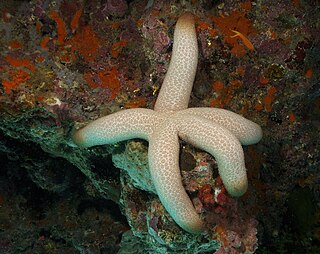
Thromidia catalai, sometimes called the heavy starfish, is a species of starfish in the family Mithrodiidae in the order Valvatida. It is native to the Indo-Pacific region. Thromidia catalai is one of the largest and heaviest starfishes in the world. It is reported to weigh as much as 6 kg (13 lb) and have a diameter of 60 to 65 cm. This species was first described by the Australian biologists E. C. Pope and F. W. E. Rowe in 1977, the type locality being New Caledonia.


